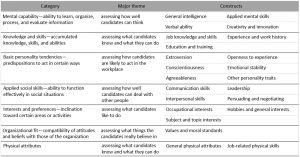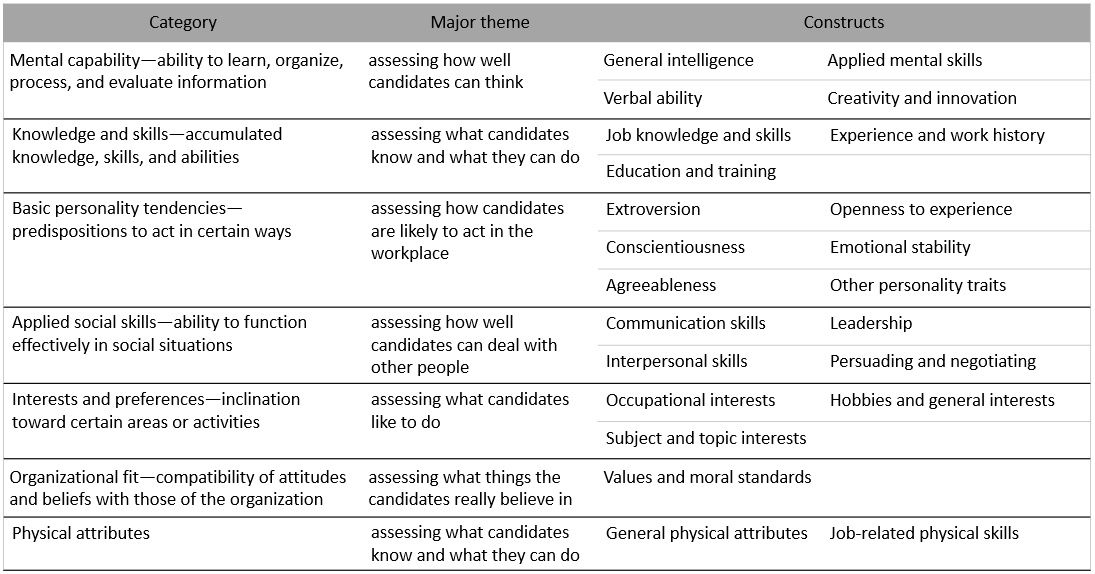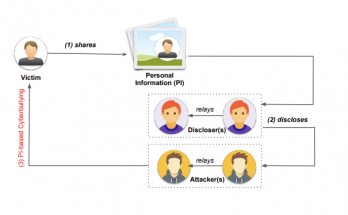The quest for work and interviews is a daunting chapter in one’s life. A job interview is a nervous phase for anyone. You walk into a strange building to meet strange people, answer questions and try to make a good impression at the same time. Even seasoned performers experience stage fright but the key to excelling at this is practice and training. My research interests lie in this aspect of helping job seekers train and practice at an interview by implementing a digital tool with the ability to give feedback.
Designing a tool to provide interview training to help job seekers come out of their unemployment spell requires an understanding of the characteristics that are assessed in an employment interview. In the search for such characteristics sought after in an interview, I came across this article – Identification and Meta-Analytic Assessment of Psychological Constructs Measured in Employment Interviews. This blog post is a brief overview of this article where we will look at a comprehensive taxonomy of 7 types of constructs that are assessed in an interview.
Constructs assessed in an employment interview have not been studied as much as the interview validity and reliability. Research on constructs assessed in an interview is not only important but complex. Interviews are designed to assess certain work-related aspects specific to a given position. These work-related aspects can be embedded with different constructs internally. For example, an interview designed to evaluate a sales position would internally assess the candidate’s communication skills. Analysis of these complex and masked constructs will give more insights into the world of recruiting and eventually help in better design of interview training systems.
The goal of the mentioned study was to begin the process of identifying and evaluating the constructs assessed in employment interviews and the authors conduct this investigation in two steps. In the first step, the authors develop a taxonomy for the different constructs or ratings and propose seven major classes consulting the existing literature in psychology. As a second step, they do a thorough review of 47 employment interview studies and identify 338 assessment characteristics. Finally, they map these characteristics into seven classes categorized earlier.
1. Taxonomy of Possible Interview Constructs
To develop the taxonomy of constructs, the authors examine the existing works in the psychological literature to identify constructs relevant to the employment interview. Specifically, they consult established constructs in applied psychology, such as in personnel selection and placement (e.g., mental ability, personality, interests and preferences); and other constructs that could be measured in an interview (e.g., organizational fit, social skills).

The table here shows the taxonomy developed by the authors. It has 7 categories along with the general theme and constructs associated with each. These categories and constructs provide a pragmatic framework to begin the process of identifying the ones captured in employment interview evaluations.
2. Mapping of Interview Constructs
The authors next map the different dimensions assessed in an interview with the developed taxonomy shown in Table 1. This investigation involved a meta-analysis of all the employment interview studies in the literature. They employed four main criteria to choose the studies.
- The study had to list the specific dimensions (i.e., characteristics) assessed
- The study had to involve a real position in business and industry
- The study had to represent a typical interview
- The study had to provide at least some supplemental information for the individual dimensions in the interview
These criteria were designed keeping in mind that the studies chosen were reasonably representative of employment interviews in general and provided a sound basis on which to analyze interview constructs. After filtering with the above criteria, the authors looked at 47 employment interview studies in total with 338 assessment characteristics. They manually coded the characteristics from these studies mapping them to the taxonomy presented earlier with a high agreement rate.
Results show that basic personality skills and applied social skills were the most assessed characteristics among the participants than any other construct. Basic personality skills (35%) reflect the largest number of characteristics assessed, followed by applied social skills (28%). The next most frequently graded constructs were mental capability (16%) and knowledge and skills (10%).
Personality and applied social skills represent behavioural patterns and provide employers with an overview of how prospective workers are likely to behave on the job and adapt to changing times and challenges. It is also indicative of how well they will communicate with other employees. These behavioural skills (combined, they account for more than 60% of all the rated characteristics) are rated more often than the knowledge and experience of the candidate irrespective of the job type.
An interview training tool should essentially include these behavioural characteristics providing useful feedback for candidates, and higher chances of getting a job. The training feedback should ideally address the same characteristics in a participant which a human interviewer would. This work notably highlights these aspects that are to be included and gives the right inclination in the design of such a tool.
Author: Pooja Rao
Reference:
Huffcutt, A. I., Conway, J. M., Stone, N. J., & Roth, P. L. (2001). Identification and Meta-Analytic Assessment of Psychological Constructs Measured in Employment Interviews. 86(5), 897–913. https://doi.org/10.1037//0021-9010.86.5.897




